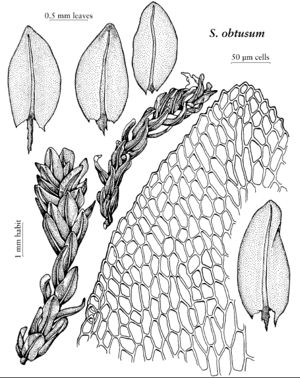Splachnobryum obtusum
Verh. K. K. Zool.-Bot. Ges. Wien 19: 504. 1869,.
Plants gregarious, small, dull, often encrusted with soil. Stems to 1 cm but mostly much shorter, distal cell of axillary hairs swollen, somewhat asymmetric, colorless, often encrusted. Leaves soft, commonly shriveled when dry, rarely uncontorted or nearly so, 0.6–0.8 mm, oblong to obovate or spatulate, sometimes decurrent from costa and margins, margins plane, or a little recurved proximally; costa weak to strong, 1/2 leaf length to nearly percurrent, sometimes spurred or forked, or both, distally. Specialized asexual reproduction by gemmae on axillary rhizoids, rare; rhizoid tubers inconspicuous, of several bulging cells in linear arrangement.
Habitat: Not producing sporophytes in the flora area. Exposed sites on damp or periodically wet limestone, marl, calcareous soil, mortar-work
Elevation: low to moderate elevations (0-1000 m)
Distribution

Ariz., Fla., La., Okla., Tex., Mexico, West Indies, Central America, South America, Africa, Pacific Islands (Hawaii).
Discussion
Splachnobryum obtusum is almost entirely restricted to base-rich substrates in the flora area and probably elsewhere in its broad range. It is an obscure moss, difficult to find in the field because of its small size, drab aspect, and absence of field characters. Most specimens from the flora area are tiny, poorly developed plants with short stems and small leaves. In the flora area, underdeveloped specimens of various other mosses, mostly Bryaceae and Pottiaceae, are sometimes misidentified as Splachnobryum. Under the microscope the leaf shape, crenulate distal leaf margin, and distal leaf cells in ascending rows diverging from the costa, are helpful for identification. The oddly shaped axillary hairs also are helpful, but often difficult to demonstrate. The leaves of many specimens of this moss are difficult to rehydrate after drying. Plants with archegonia are common in at least some of the material seen. Rhizoid tubers, as reported by T. Arts (1996) for African specimens of S. obtusum, are present in at least some of the specimens from the flora area, including the New Orleans material.
Selected References
None.
